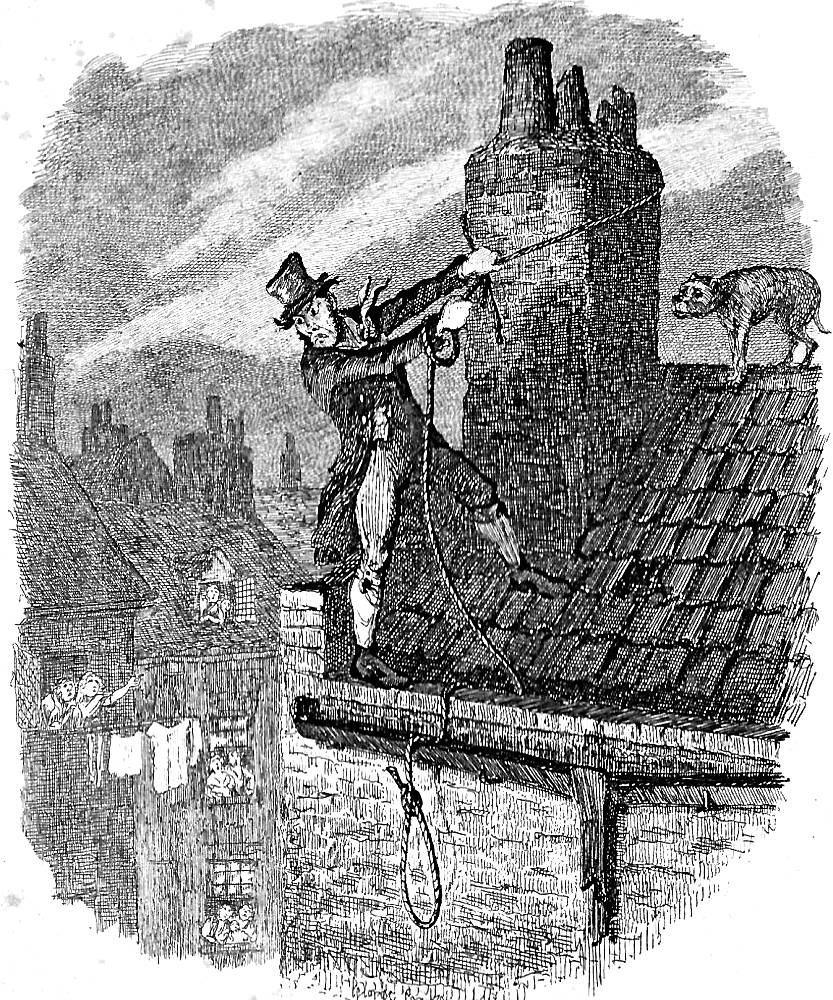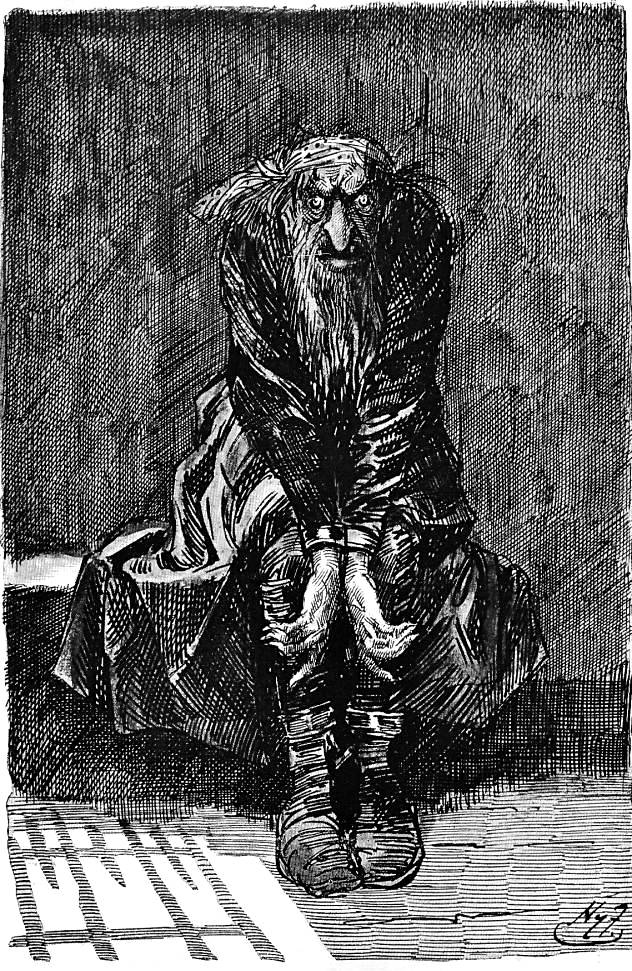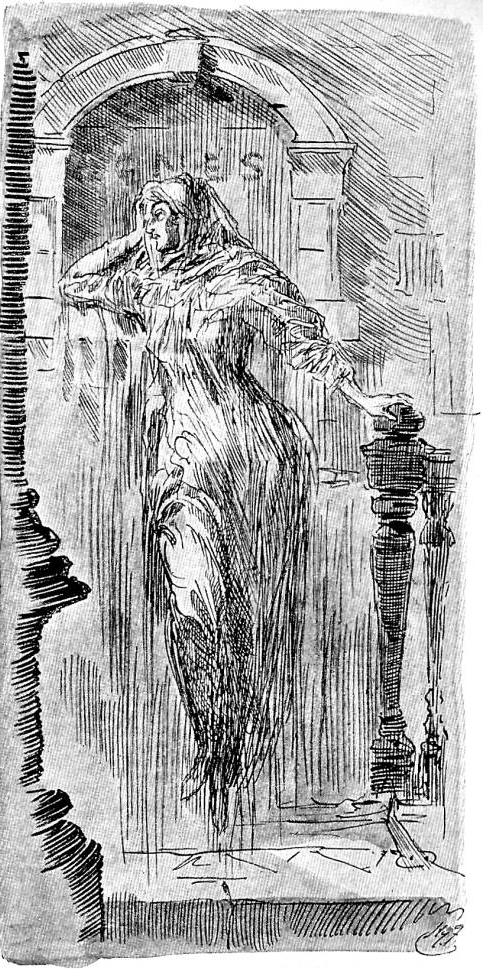
"Do you know this young lady, sir?" — James Mahoney's innovative plate with no parallel in the original serial, November 1838 and 1846 volume editions illustrated by George Cruikshank. As Dickens draws the many strands of the complicated "inheritance" plot together in Chapter 51 for the Household Edition, Mahoney provides a rendition of a scene not previously attempted in illustration, a somewhat stilted interview between the reluctant Monks and Oliver's mentors, Rose Maylie and Mr. Brownlow (centre), an interview in which the evil half-brother confesses all, enlightening the principals and the readers about Oliver's and Rose's back-stories. In the original narrative-pictorial serial sequence in Bentley's Miscellany for Part 24, April 1839, the periodical reader encountered a neurotic Fagin awaiting execution in Fagin the Condemned Cell in "Fagin's Last Night Alive," in The Adventures of Oliver Twist; or, The Parish Boy's Progress, but found no illustration in the previous monthly part to conclude Monks's involvement in Oliver's "Progress." The Mahoney illustration is less melodramatic than Cruikshank's portrait of Fagin (and less psychological) and not sensational in any way, as opposed to The Last Chance, which accompanied serial Part 22. Given such interesting subjects, Cruikshank does not underscore the importance of the interview in bringing the mystery behind Monks's persecution of Oliver and the early history of the sisters Agnes Fleming and Rose Maylie to a denouement, and in meting out poetic justice to the obsessed Monks (Edwin Leeford). The passage realised actually occurs four pages later, so that one must read the the illustration proleptically, then flip back to it once one reaches page 197). The illustration itself is positioned at the beginning of Chapter 51, although before the original serial's curtain (in the Household Edition, p. 194). 1871. Wood engraving by the Dalziels, 10.6 cm high by 13.7 cm wide.
Scanned image and text by Philip V. Allingham. [You may use this image without prior permission for any scholarly or educational purpose as long as you (1) credit the person who scanned the image and (2) link your document to this URL in a web document or cite the Victorian Web in a print one.].
Passage Illustrated
"Young lady," said Mr. Brownlow, turning to Rose, "give me your hand. Do not tremble. You need not fear to hear the few remaining words we have to say."
"If they have — I do not know how they can, but if they have — any reference to me," said Rose, "pray let me hear them at some other time. I have not strength or spirits now."
"Nay," returned the old gentleman, drawing her arm through his; "you have more fortitude than this, I am sure. Do you know this young lady, sir?"
"Yes," replied Monks.
"I never saw you before," said Rose faintly.
"I have seen you often," returned Monks.
"The father of the unhappy Agnes had two daughters," said Mr. Brownlow. "What was the fate of the other — the child?"
"The child," replied Monks, "when her father died in a strange place, in a strange name, without a letter, book, or scrap of paper that yielded the faintest clue by which his friends or relatives could be traced — the child was taken by some wretched cottagers, who reared it as their own."
"Go on," said Mr. Brownlow, signing to Mrs. Maylie to approach. "Go on!
[Chapter 51, "Affording an Explanation of More Mysteries Than One, and Comprehending a Proposal of Marriage with No Word of Settlement or Pin-Money," p. 197]
Commentary
To avoid punishment, Monks under duress (a mental state which his posture in the Mahoney illustration suggests) agrees to disclose why he has been relentlessly pursuing Oliver, in league with Fagin, in order to void the will of Edwin Leeford in Oliver's favour. Since the truth about the will is the centrepiece, so to speak, of Monks's testimony, it is odd that Mahoney did not choose as his subject the moment that originally concluded the twenty-second instalment:
"Go on," said the person addressed, turning away his face. "Quick. I have almost done enough, I think. Don't keep me here."
"This child,' said Mr. Brownlow, drawing Oliver to him, and laying his hand upon his head, "is your half-brother; the illegitimate son of your father, my dear friend Edwin Leeford, by poor young Agnes Fleming, who died in giving him birth." [Chapter 51, Household Edition, p. 194]
Although the entire chapter is found intact in the editions of 1838 and 1846, Dickens (probably out of publication necsssity) chose to break the chapter to form a curtain, for the reader of Bentley's Miscellany in February 1839 must certainly have been in anticipation to read what Oliver would say and what would be his reaction to this figure out of nightmare now become a reality. Now, to both the reader and to Oliver, his peculiar behaviour and unrelenting pursuit of the boy make complete sense. However, Mahoney instead chose to bring Rose Maylie forward to confront the duplicitous Leeford, the whole interrogation stage-managed by Edwin Leeford's best friend, Mr. Brownlow. For the sake of enjoying the sheer melodrama of Monks's comeuppance the reader is willing to forgive Dickens for the multiple coincidences he has constructed to bring the reader to this moment in the twenty-two months of text. However, Mahoney has passed over the moment when Monks and Oliver meet formally to focus on Rose's introduction to her sister's nemesis. Of what forbearance of such a scurrilous individual, of what forgiveness of such persecution, will the noble, self-sacrificing Rose be capable?
Whereas Harry Furniss in his 1910 lithographic series offers three illustrations depicting the characters and events in the final chapters of the novel: the character studies of the noble Rose Maylie, the savage, terrified master-thief Fagin in the Condemned Cell, and the rendition of a ghostly young woman resembling Rose, The Shade of Agnes, he does not follow the practice of 1870s Household Edition illustrator James Mahoney in depicting Monks as he is compelled to tell the truth to Oliver and his friends.
The interview, which follows hard upon the heels of Sikes's gruesome death on Jacob's Island, for the Victorian reader would emphasized divine intervention in human affairs rather than mere coincidence or miscalculation.
By the time that the reader of the text reaches the moment which the illustration has realised, Monks has imparted what he knows about his mother's conduct, the destruction of the will, and the cause of his inveterate hatred of Oliver, and admits to having suborned the Bumbles in order to destroy the locket and the ring which had been Agnes Fleming's final effects. Moreover, Grimwig has introduced the Bumbles, who at first even deny that they have had secret dealings with Monks. Brownlow has sworn that neither husband nor wife will ever be employed in a position of public trust. All of these revelations have proven almost too much for Rose to bear. However, for Mr. Brownlow's sake, she hears Monks's account of her own childhood and the circumstances under which the Maylies adopted her. The illustration thus shifts the reader's attention from Monks's mother's destruction of her husband's will towards the background of Rose, a subplot at best; however, this disclosure clears the way for Harry to marry her.
Thus, a careful reading of the latter half of the chapter, which originally fell in the twenty-third instalment, reveals the identities of the figures in the picture: Monks, face face largely hidden from the reader (left); the table with Brownlow's record (left of centre); and in the right register, Rose and Mr. Brownlow, Mr. Grimwig, Oliver, and Mrs. Maylie. The revelation of Rose's birth and early adoption makes it clear that she is not illegitimate. On the left, the sinister figure of Monks is alienated, cut off from the stratum of society in which he belongs, and, without the further assistance of his dissolute friends, powerless and alone. On the right, the forces of virtue have come together to wring Leeford's knowledge from him about Oliver's birthright, and prepare the reader for Monks's exile. In a complicated chapter full of detailed flashbacks that the readers, like the characters on the right of the picture must piece together, Mahoney has focussed on Rose and her back-story to make the text more intelligible.
Relevant Illustrations from the serial edition wrapper (1839) and Charles Dickens Library Edition (1910)



Left: George Cruikshank's depiction of the moment prior to Sikes's death, The Last Chance (1838). Centre: Harry Furniss's Charles Dickens Library Edition illustration Rose Maylie (1910). Right: Harry Furniss's final illustration, The Shade of Agnes (1910). [Click on images to enlarge them.]
References
Bentley, Nicolas, Michael Slater, and Nina Burgis. The Dickens Index. New York and Oxford: Oxford U. P., 1990.
Cohen, Jane Rabb. "George Cruikshank." Charles Dickens and His Original Illustrators. Columbus: Ohio State U. P., 1980. Pp. 15-38.
Darley, Felix Octavius Carr. Character Sketches from Dickens. Philadelphia: Porter and Coates, 1888.
Davies, Philip. "Warren of Sunless Courts." Lost London, 1870-1945. Croxley Green, Hertfordshire: Transatlantic, 2009. Pp. 258-60.
Davis, Paul. Charles Dickens A to Z: The Essential Reference to His Life and Work. New York: Facts On File, 1998.
Dickens, Charles. The Letters of Charles Dickens. Ed. Graham Storey, Kathleen Tillotson, and Angus Eassone. The Pilgrim Edition. Oxford: Clarendon, 1965. Vol. 1 (1820-1839).
Dickens, Charles. The Adventures of Oliver Twist. Works of Charles Dickens. Household Edition. Illustrated by James Mahoney. London: Chapman and Hall, 1871.
Dickens, Charles. The Adventures of Oliver Twist. Illustrated by George Cruikshank. London: Bradbury and Evans; Chapman and Hall, 1846.
Dickens, Charles. The Adventures of Oliver Twist. Works of Charles Dickens. Household Edition. 55 vols. Illustrated by F. O. C. Darley and John Gilbert. New York: Sheldon and Co., 1865.
Dickens, Charles. Oliver Twist. Works of Charles Dickens. Diamond Edition. 18 vols. Illustrated by Sol Eytinge, Jr. Boston: Ticknor and Fields, 1867.
Dickens, Charles. Oliver Twist. The Annotated Dickens. Ed. Edward Guiliano and Philip Collins. New York: Clarkson N. Potter, 1986. Vol. 1. Pp. 534-823.
Dickens, Charles. The Adventures of Oliver Twist. Works of Charles Dickens. Charles Dickens Library Edition. Illustrated by Harry Furniss. London: Educational Book Company, 1910. Vol. 3.
Forster, John. "Oliver Twist 1838." The Life of Charles Dickens. Ed. B. W. Matz. The Memorial Edition. 2 vols. Philadelphia: J. B. Lippincott, 1911. Vol. 1, book 2, chapter 3. Pp. 91-99.
Kitton, Frederic G. "George Cruikshank." Dickens and His Illustrators: Cruikshank, Seymour, Buss, "Phiz," Cattermole, Leech, Doyle, Stanfield, Maclise, Tenniel, Frank Stone, Topham, Marcus Stone, and Luke Fildes. 1899. Rpt. Honolulu: U. Press of the Pacific, 2004. Pp. 1-28.
Lynch, Tony. "Jacob's Island, London." Dickens's England: An A-Z Tour of the Real and Imagined Locations. London: Batsford, 2012. Pp. 122.
Created 30 December 2014